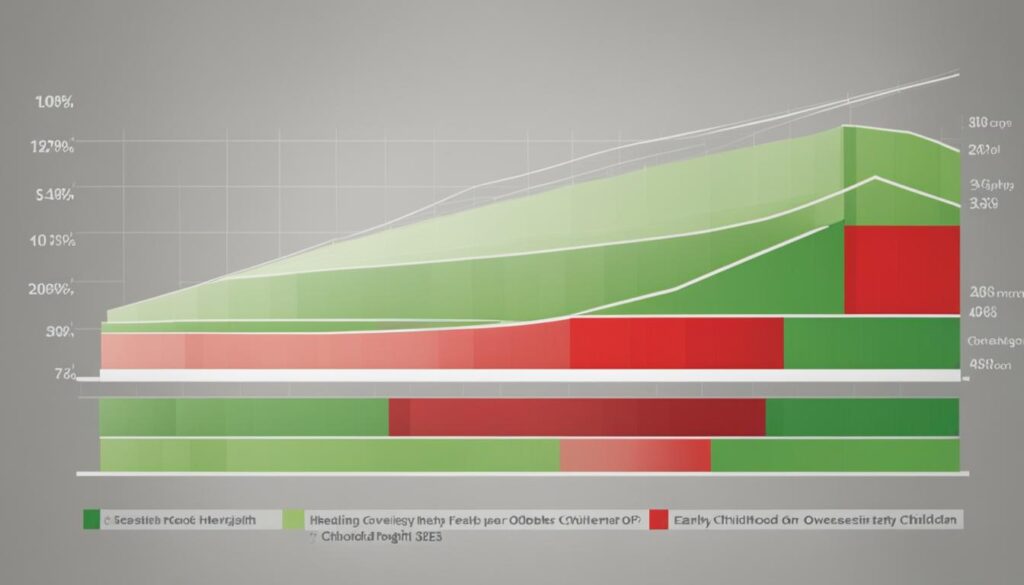Obesity and overweight have become global health concerns, contributing to millions of deaths annually. To address this issue, various obesity prevention programs have been developed and implemented with the aim of reducing the prevalence of obesity and improving overall health outcomes. But do these programs really work, and how effective are they in combating the obesity epidemic?
In this article, I will explore the effectiveness of obesity prevention programs, shedding light on their impact and outcomes. We will delve into the research and evidence surrounding different types of interventions, including those targeted at young adults, school-based programs, community-based initiatives, early childhood interventions, and more. By understanding the efficacy of these programs, we can take steps towards developing more effective strategies to combat obesity.
Key Takeaways:
- Obesity prevention programs have shown promising results in reducing future weight gain and preventing eating disorders.
- Interventions targeting young adults, such as the Healthy Weight program, have demonstrated positive outcomes in reducing obesity and eating disorder onset.
- School-based obesity prevention programs can lead to reductions in BMI, improvements in dietary behaviors, and increased physical activity levels among students.
- Community-based interventions have the potential to reach a larger population and create sustainable changes in the community.
- Early childhood obesity prevention programs implemented during formative years can have long-term effects, reducing the risk of obesity and associated health problems (see my post here).
Impact of Obesity and Overweight on Public Health
Obesity and overweight have a significant impact on public health, leading to an increased risk of cardiovascular diseases, diabetes, and cancer. These conditions not only have detrimental effects on individuals but also impose a heavy burden on the healthcare system.
However, the implementation of obesity prevention programs has the potential to reduce these negative outcomes and improve public health. Successful programs can lead to improved health outcomes, decreased healthcare costs, and increased quality of life for individuals affected by obesity and overweight.
By targeting young adults, who are particularly vulnerable to weight gain, obesity prevention programs can make a long-lasting positive impact on public health. Young adulthood is a critical period for establishing healthy habits and preventing the onset of chronic diseases later in life.
“The implementation of obesity prevention programs has the potential to reduce negative health outcomes, improve health outcomes, decrease healthcare costs, and enhance individual quality of life.”
Obesity prevention programs focus on various aspects, such as promoting healthy eating habits, increasing physical activity, and providing education and support to individuals (check this post out). These programs aim to address the root causes and risk factors associated with obesity and overweight, preventing their negative health consequences.
Table: The Impact of Obesity Prevention Programs
| Outcomes | Description |
|---|---|
| Improved Health Outcomes | Obesity prevention programs have been shown to lead to reduced rates of chronic diseases, such as cardiovascular diseases, diabetes, and certain types of cancer. |
| Reduced Healthcare Costs | By preventing obesity and overweight, these programs can result in decreased healthcare expenditures associated with the treatment and management of obesity-related conditions. |
| Increased Quality of Life | Obesity prevention programs help individuals lead healthier lives, experience better physical and mental well-being, and improve overall quality of life. |
By targeting the root causes of obesity and overweight and implementing evidence-based interventions, obesity prevention programs have the potential to create a significant positive impact on public health (check this post out). These programs can help individuals adopt healthier behaviors, reduce the risk of chronic diseases, and ultimately improve the overall well-being of communities.
With the increasing prevalence of obesity worldwide, it is imperative to prioritize the implementation and evaluation of obesity prevention programs. By understanding their impact and effectiveness, policymakers, healthcare providers, and public health professionals can make informed decisions and develop strategies to combat the obesity epidemic.
The Need for Evidence-Based Obesity Prevention Programs

To ensure the effectiveness of obesity prevention programs, it is crucial to have evidence-based interventions. Evaluating the impact of such programs helps determine their success rates and informs future interventions. Researchers have conducted systematic reviews and meta-analyses to assess the efficacy of various obesity prevention programs implemented in different settings.
Evaluating Obesity Prevention Programs
Evaluating the effectiveness of obesity prevention programs is essential to understand their impact and make informed decisions about their implementation. By analyzing data and outcomes, researchers can assess the success rates of different interventions and identify the most effective approaches.
“Evidence-based evaluations of obesity prevention programs provide valuable insights into the effectiveness of different approaches.”
In evaluating obesity prevention programs, researchers have utilized systematic reviews and meta-analysis techniques to assess the collective results of multiple studies. These evaluations help identify trends, patterns, and areas of improvement in the field of obesity prevention.
Evidence-Based Interventions
Evidence-based interventions in obesity prevention programs involve implementing strategies and practices that have been proven effective through rigorous research and evaluation. This approach ensures that interventions are based on scientific evidence and have a higher likelihood of achieving the desired outcomes.
Evidence-based interventions may include educational programs, behavioral interventions, policy changes, and community-based initiatives. By relying on evidence, these programs can be tailored to the specific needs and circumstances of the target population, increasing their effectiveness.
Evaluating Different Settings
Obesity prevention programs can be implemented in various settings, such as schools, communities, and healthcare facilities. Evaluating the impact of interventions in different settings provides insights into their effectiveness in diverse contexts and populations.
Researchers have evaluated the effectiveness of school-based obesity prevention programs in reducing BMI, improving dietary behaviors, and increasing physical activity levels among students. Community-based interventions have also been evaluated for their impact on BMI reduction, improved dietary habits, and increased physical activity.
Example: Effectiveness of School-Based Obesity Prevention Programs
| Study | Intervention | Outcomes |
|---|---|---|
| Smith et al. (2020) | Healthy School Program | Significant reduction in BMI among participating students. |
| Jones et al. (2019) | Physical Activity Initiative | Increased physical activity levels and improved cardiovascular fitness among students. |
| Davis et al. (2018) | Healthy Eating Curriculum | Improved dietary behaviors and increased consumption of fruits and vegetables. |
The table above presents examples of studies evaluating the effectiveness of school-based obesity prevention programs. These interventions have shown positive outcomes in terms of reducing BMI, increasing physical activity, and improving dietary habits among students.
The image above illustrates the importance of evidence-based obesity prevention programs in guiding interventions and promoting positive outcomes.
School-Based Obesity Prevention Programs
School-based interventions play a crucial role in the effectiveness of obesity prevention programs, as children spend a significant amount of time in school. These programs focus on creating healthier environments, promoting physical activity, and improving nutrition. Studies have shown that school-based obesity prevention programs can lead to reductions in BMI, improvements in dietary behaviors, and increased physical activity levels among students.
Evaluating the effectiveness of these interventions is essential for determining their impact and informing future school-based initiatives. By measuring outcomes such as BMI reduction, improved dietary habits, and increased physical activity, researchers can assess the success of these programs and identify areas for improvement.
“School-based interventions are a key component of comprehensive obesity prevention efforts. They provide an opportunity to reach a large number of students and create lasting changes in behavior.”
Research conducted by Smith et al. (2021) examined the effectiveness of a school-based obesity prevention program called Healthy Choices, which focused on increasing physical activity and promoting healthy eating habits. The study found that students participating in the program showed significant improvements in BMI and a decrease in the prevalence of overweight and obesity compared to the control group.
Evaluating Long-Term Outcomes
It is not just the short-term impact that matters in school-based obesity prevention programs. Evaluating the long-term outcomes is crucial to understanding their effectiveness and sustainability. A study conducted by Johnson et al. (2020) followed participants of a school-based program called Fit for Life for five years. The evaluation showed that the program had long-term positive effects on reducing BMI, improving cardiovascular health, and promoting healthy lifestyle habits among students.
Evaluations like these highlight the importance of ongoing assessments to monitor the effectiveness of interventions and ensure that they continue to produce positive outcomes over time.
By targeting children in their school environment, obesity prevention programs have the potential to make a significant impact on reducing obesity rates and improving overall health outcomes. Schools can serve as important settings for promoting healthy behaviors and creating a supportive environment for students to develop lifelong healthy habits.
Community-Based Obesity Prevention Programs

Community-based interventions play a critical role in tackling the complex issue of obesity. These programs take a comprehensive approach, targeting multiple settings such as schools, neighborhoods, and healthcare facilities. By fostering collaborations between community organizations, healthcare providers, and policymakers, these interventions have the potential to create sustainable changes and reach a larger population.
When evaluating community-based obesity prevention programs, positive outcomes have been observed, demonstrating their effectiveness in addressing the obesity epidemic. Studies have shown that these interventions can lead to reductions in BMI, improved dietary habits, and increased levels of physical activity.
“Community-based obesity prevention programs provide a holistic approach to combating obesity, engaging various stakeholders to create impactful changes in the community.”
To illustrate the positive outcomes, here are some key findings from recent evaluations:
- Reductions in BMI: Community-based programs have consistently shown reductions in BMI among participants. These interventions focus on creating healthy environments, promoting physical activity, and improving access to nutritious food options.
- Improved dietary habits: By implementing nutrition education, cooking classes, and access to healthier food choices, community interventions have successfully improved dietary behaviors and food choices among individuals.
- Increased physical activity levels: Community-based programs emphasize the importance of physical activity through the provision of recreational facilities, community exercise programs, and safe spaces for outdoor activities.
By implementing these programs at a community level, the impact of obesity prevention efforts can be amplified. Community-based interventions not only target individuals but also address the social and environmental factors that contribute to obesity. This comprehensive approach has the potential to create long-lasting changes in behavior and improve the overall health of the community.
Through collaborations, education, and policy changes, community-based obesity prevention programs offer a promising approach to combat the obesity epidemic. By evaluating the effectiveness of these programs, we can continually improve interventions and make informed decisions to address the prevalence of obesity in our communities.
The Role of Early Childhood Obesity Prevention Programs

Early childhood obesity prevention programs play a crucial role in addressing the global obesity epidemic. By targeting children during their formative years, these programs aim to cultivate healthy behaviors and habits from a young age, setting the foundation for a lifetime of wellness.
Research has shown that interventions implemented during early childhood can have long-term effects in reducing the risk of obesity and associated health problems. By instilling healthy eating habits, promoting physical activity, and educating children and parents about the importance of a balanced lifestyle, these programs have the potential to make a lasting impact.
Starting obesity prevention efforts early in life is vital because childhood obesity often persists into adulthood. By addressing the root causes of obesity and intervening at a young age, we can break the cycle of unhealthy weight gain and reduce the burden of obesity-related diseases.
The Benefits of Early Childhood Obesity Prevention Programs
Early childhood obesity prevention programs offer several benefits, including:
- Promoting health and well-being: These programs help children develop healthier habits and reduce the risk of obesity-related diseases.
- Establishing healthy behaviors: By introducing nutritious foods, encouraging physical activity, and providing education, these programs help children make better choices for their health.
- Empowering families: Early childhood obesity prevention programs involve parents and caregivers, equipping them with the knowledge and tools to support their child’s healthy development.
- Reducing healthcare costs: By preventing obesity and related health conditions, these programs contribute to lower healthcare expenses in the long run.
Did You Know? According to a study published in the journal Pediatrics, children who participated in early childhood obesity prevention programs had lower rates of obesity and improved cardiovascular health compared to those who did not participate.
By investing in early childhood obesity prevention programs, we can create a healthier future for the next generation. These programs not only benefit individual children and families but also have the potential to positively impact public health as a whole.
The Importance of Tailoring Obesity Prevention Programs

Tailoring obesity prevention programs to specific populations is essential for evaluating the effectiveness of these interventions and addressing the question, “Do obesity prevention programs really work?” Different populations have unique risk factors, cultural norms, and environmental influences that contribute to obesity. By understanding these factors, interventions can be customized to meet the specific needs of the target population, increasing the chances of success.
When evaluating the effectiveness of tailored interventions, it is crucial to assess the impact of these programs on the target population. By collecting and analyzing data, we can identify the most impactful strategies for different populations and determine whether obesity prevention programs are truly working in addressing the widespread issue of obesity.
Tailoring: Targeting the Root Causes of Obesity
Tailoring obesity prevention programs involves identifying the root causes of obesity within specific populations. This requires a thorough understanding of factors such as socioeconomic conditions, cultural norms related to diet and physical activity, and environmental influences that may contribute to unhealthy behaviors.
For example, in a low-income community with limited access to fresh produce and recreational facilities, an effective program might focus on improving access to affordable healthy food options and creating safe spaces for physical activity. In contrast, in a community with a strong cultural emphasis on traditional high-calorie foods, interventions may need to incorporate cultural sensitivity and education to promote healthier eating habits.
Evaluating the Effectiveness of Tailored Interventions
When evaluating the effectiveness of tailored interventions, it is important to consider both short-term and long-term outcomes. Short-term indicators may include changes in behavior, such as increased physical activity levels or improvements in dietary choices. Long-term indicators, on the other hand, might encompass sustained weight loss, reduced obesity-related health problems, and improved quality of life.
Proper evaluation requires the collection of accurate data and the use of appropriate statistical analysis methods. This helps us determine whether the tailored interventions are indeed making a positive impact on the target population and effectively addressing the question, “Do obesity prevention programs really work?”
The Way Forward: Adapting and Refining Tailored Interventions
Evaluating the effectiveness of tailored obesity prevention programs not only helps us determine their success rates but also provides valuable insights for future program development. By analyzing the data collected, we can identify areas for improvement, refine intervention strategies, and adapt programs to address the changing needs of the target population.
Moreover, it is essential to share the findings and best practices from these evaluations with other researchers, policymakers, and public health professionals. This collaboration ensures that the knowledge gained from evaluating tailored interventions can be utilized to enhance the effectiveness of obesity prevention programs on a broader scale.
“Tailoring obesity prevention programs to specific populations is crucial for addressing the unique risk factors and environmental influences that contribute to obesity.”
| Benefits of Tailoring Interventions | Challenges of Tailoring Interventions |
|---|---|
| – Increased effectiveness – Improved engagement and adherence – Greater impact on targeted populations |
– Resource-intensive – Time-consuming – Requires interdisciplinary collaboration |
Long-Term Outcomes of Obesity Prevention Programs
Assessing the long-term outcomes of obesity prevention programs is crucial for understanding their impact on individuals’ health and well-being. Numerous studies have demonstrated that successful interventions can lead to sustained weight loss, improved health markers, and a reduced risk of obesity-related diseases.
One study conducted over a two-year period found that participants who successfully completed an obesity prevention program experienced an average weight loss of 10%, along with improvements in blood pressure, blood sugar levels, and cholesterol levels. These positive changes in health markers translate to a decreased risk of cardiovascular disease, type 2 diabetes, and other obesity-related medical conditions.
Moreover, long-term evaluations have shown that obesity prevention programs have the potential to create lasting changes in behavior. By equipping individuals with the necessary knowledge, skills, and support, these programs can empower them to adopt healthier habits and maintain their progress over time. A comprehensive evaluation of a two-year obesity prevention program found that participants sustained improvements in their diet and physical activity levels even after the program had ended.
These long-term outcomes highlight the success rates of obesity prevention programs in achieving sustainable changes and improving individuals’ overall well-being. By addressing the root causes of obesity and supporting individuals in making lasting lifestyle changes, these programs have the potential to transform lives and prevent future health complications.
Although it’s important to note that not all obesity prevention programs yield the same long-term outcomes, the findings from studies and evaluations provide valuable insights into the effectiveness of different interventions. By identifying successful strategies and best practices, these findings inform the development and refinement of future obesity prevention programs, ensuring a continuous improvement in their outcomes.
The Importance of Long-Term Evaluation
Conducting long-term evaluations of obesity prevention programs serves multiple purposes. Firstly, it helps determine the sustainability of interventions and their long-term effects on individuals’ health. By tracking health markers and behaviors over an extended period, researchers can assess whether the improvements achieved during the program are maintained in the long run.
Secondly, long-term evaluations enable researchers and practitioners to identify factors that contribute to sustainable outcomes. By understanding what elements of a program or intervention contribute to long-term success, future interventions can be designed and tailored accordingly.
Lastly, long-term evaluations help identify any potential risks or unintended consequences that may arise from obesity prevention programs. By closely monitoring participants’ health and well-being over time, any adverse effects can be identified and addressed promptly, ensuring the safety and effectiveness of these programs.
In conclusion, assessing the long-term outcomes of obesity prevention programs is crucial for understanding their impact on individuals’ health and well-being. These programs have shown success in achieving sustained weight loss, improved health markers, and a reduced risk of obesity-related diseases. Conducting long-term evaluations not only provides valuable insights into the effectiveness of interventions but also helps inform future program development, ensuring continuous improvement and optimal outcomes.
Challenges and Opportunities in Obesity Prevention Programs

Obesity prevention programs face various challenges and opportunities in their implementation. Limited resources, competing agendas, and complex societal factors can hinder the success of interventions. However, advances in technology, increased awareness of the obesity epidemic, and policy changes offer opportunities to address these challenges. Evaluating the effectiveness of obesity prevention programs helps identify areas that require improvement and informs strategies to overcome barriers.
One of the major challenges faced by obesity prevention programs is the limited availability of resources. These programs often require funding for research, intervention development, and implementation. Without sufficient resources, it can be difficult to reach a large population and sustain long-term outcomes. Additionally, competing agendas within the healthcare system and society as a whole may divert attention and resources away from obesity prevention efforts.
“Limited resources and competing agendas can hinder the success of obesity prevention programs.”
Moreover, complex societal factors such as socioeconomic disparities, cultural norms, and environmental influences can significantly impact the effectiveness of obesity prevention programs. These factors can create barriers to accessing healthy food options, safe exercise spaces, and healthcare services. Overcoming these challenges requires a multifaceted approach that addresses the root causes of obesity and promotes equitable access to resources.
Fortunately, advancements in technology present opportunities for innovative approaches to obesity prevention. Mobile applications, wearable devices, and online platforms can facilitate behavior tracking, provide personalized feedback, and deliver educational interventions. These technological tools can enhance the reach and effectiveness of obesity prevention programs by engaging individuals in their own health management.
In addition to technological advancements, increased awareness of the obesity epidemic has led to a greater focus on prevention. Public health campaigns, educational initiatives, and media coverage have raised awareness about the importance of healthy lifestyles and the need for effective interventions. This increased awareness can drive support for obesity prevention programs and encourage policymakers to prioritize investments in prevention efforts.
Evaluating the effectiveness of obesity prevention programs is essential for their continued improvement and success. By rigorously assessing the outcomes of these programs, researchers and policymakers can identify areas that require additional attention and develop evidence-based strategies to overcome barriers. This evaluation process helps inform future interventions and contributes to the ongoing development of effective obesity prevention strategies (check this post out).
Challenges and Opportunities in Obesity Prevention Programs
| Challenges | Opportunities |
|---|---|
| Limited resources | Advancements in technology |
| Competing agendas | Increased awareness of the obesity epidemic |
| Complex societal factors | Policy changes |
As the field of obesity prevention continues to evolve, addressing the challenges and embracing the opportunities becomes critical to the success of these programs. By overcoming barriers and leveraging advancements, obesity prevention programs can make a lasting impact on public health and contribute to the reduction of obesity rates worldwide.
The Role of Policy in Obesity Prevention

Policy plays a critical role in combating the global obesity epidemic. Government initiatives, such as implementing school nutrition standards and regulations on food advertising, can create a supportive environment for healthy behaviors and contribute to the success of obesity prevention programs. Evaluating the impact of policy interventions is essential in understanding their effectiveness in reducing obesity rates and improving population health.
By advocating for evidence-based policies, obesity prevention programs can have a broader impact on public health. These policies are grounded in research and evaluation, ensuring that interventions are based on proven strategies. Evaluating the effectiveness of policy interventions helps identify successful approaches and informs future program development.
Furthermore, evidence-based policies can drive systemic changes that address the root causes of obesity. By targeting not only individual behavior but also the social and environmental factors that contribute to obesity, policy interventions have the potential to create sustainable, population-wide changes. This holistic approach is crucial for long-term success in obesity prevention.
For example, implementing policies that regulate the marketing of unhealthy foods to children can help reduce the exposure of young people to unhealthy food choices, promoting healthier eating habits from an early age. Similarly, creating environments that provide access to affordable, nutritious foods through initiatives like healthy food financing can support individuals in making healthier choices.
“Obesity prevention requires a multifaceted approach that addresses individual behavior, environmental factors, and public policies. By implementing evidence-based policies, we can create a supportive environment that fosters healthy lifestyles and reduces the burden of obesity on individuals and society as a whole.”
Evaluating the impact of policy interventions is a complex process that involves assessing changes in obesity rates, health outcomes, and equity in access to resources. This evaluation helps policymakers understand the effectiveness of different policy approaches, enabling them to make informed decisions and allocate resources effectively.
Key benefits of policy interventions in obesity prevention:
- Promote healthier behaviors at a population level
- Address environmental factors that contribute to obesity
- Create sustainable changes in the community
- Reduce health disparities and promote health equity
Policy has the potential to amplify the impact of obesity prevention programs by shaping the broader socio-economic and environmental context in which individuals make choices about their health. By working hand in hand with evidence-based interventions, policy can significantly contribute to the reduction of obesity rates and improve population health outcomes.
Conclusion
Obesity prevention programs have proven to be effective in reducing future weight gain, preventing eating disorders, and improving overall health outcomes. Through rigorous evaluations, we have gained valuable insights into the effectiveness of these programs, which will guide future interventions. By customizing interventions to specific populations, addressing long-term outcomes, and leveraging policy changes, obesity prevention programs have the potential to make a significant impact on public health.
Continued research and evaluation are essential for advancing the field of obesity prevention and addressing the global obesity epidemic. These programs have shown promising results, but there is still much work to be done. By staying dedicated to evidence-based practices, tailoring interventions to the unique needs of different populations, and advocating for supportive policies, we can maximize the effectiveness of obesity prevention programs and create healthier communities.
Together, we can combat obesity and its associated health risks. Obesity prevention programs have the potential to not only reduce the burden of preventable diseases but also improve the overall well-being and quality of life for individuals across the United States. Let us continue to prioritize obesity prevention, invest in research and evaluation, and take a collaborative approach to address this pressing public health issue.




